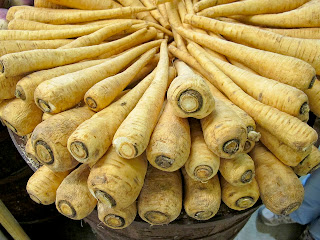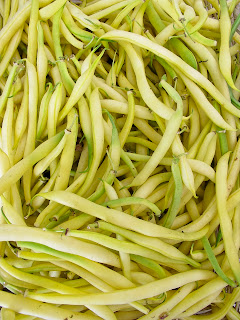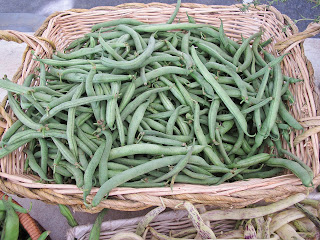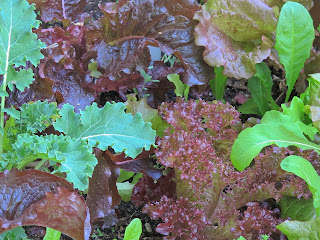A place to share some thoughts on growing lettuce, photos of veggies, and other things . . .
3960

Ruby
Wednesday, August 31, 2011
Saturday, August 27, 2011
Bees
Remember that our fruits and veggies need good healthy bees. Plant some flowers to help them out, but also support your local beekeepers and buy some great local honey. Try it in your coffee or tea: it’s better for you than sugar.
Tuesday, August 23, 2011
Saturday, August 20, 2011
Thursday, August 18, 2011
Critter Intervention
Birds, squirrels, and other creatures are likely to get into your garden and either eat the seedlings or uproot them. After trying a variety of things that didn’t work very well, I started to make little cages using poultry wire. The wire I used was 3 ft. wide, and it has a sort of seam at each foot of the width. I cut the wire into strips the full 3 feet wide by a foot, leaving bits of the hexagon on either edge. I then cut 1 ft. pieces and, folding the longer strips into thirds, inserted the 1 ft. pieces and twisted the ends together to make a cube with one end open. These little cubes can be placed over the seedlings until the plants start to fill out and become strong. At some point, the birds and squirrels will usually leave them alone. They will probably give some protection against rabbits but not sure about woodchucks. In the spring, when there are strong rain storms, I also put some stiff plastic board on top with a brick, which then works like an umbrella to keep the small plants from getting pounded in the mud. It’s extra work, but in my small garden it really has helped the plants survive.
Wednesday, August 17, 2011
Sunday, August 14, 2011
Kale
Having a couple of kale plants in your garden can provide enough for a nice soup or substitute for dishes that would call for spinach. Full of nutrients and easy to grow, try to find a little room for Lacinato or Dwarf Blue Curled Scotch in a back row somewhere. Be careful, as they will want to take over the garden if given time. They are hearty plants that will live through the winter and it’s said taste better after the first frost. Other kales like Red Russian and True Siberian are also very good during cool weather but have a harder time during warm weather. All will make a fine fall or spring crop.
We have a nice Tuscan Bean Soup recipe that we enjoy throughout the year, as well as a Stromboli recipe that can be eaten fresh or make an extra to freeze. Also try a Kale Lasagna (you can use the filling for this lasagna in the Stromboli recipe).
Saturday, August 13, 2011
Friday, August 12, 2011
Trial and Error:
Most of us are not going to have the ideal plot for a garden. If you are a backyard gardener, you will have to do with what you have available. You can of course improve the soil which is an ongoing process, use raised beds, make a trellis for cucumbers or beans to climb on etc.; but, some things like not having full sun through the day because of buildings or trees, you can’t do much about. This is why you will have to experiment with your choices of plants and placement in your garden. Some plants will benefit from having afternoon shade during the hottest weather, and others will thrive in the sun all day with proper watering. A good plan is to try different plants in various parts of your garden and to observe which do well where: you may even want to keep a few notes for next year. Since people are gardening all over the world and may have different conditions than you, some of their ideas, like mine, may or may not work for you. Be creative (improvise, adapt) and don’t give up if something doesn’t work the first time tried.
With this in mind, read other blogs, books on vegetable gardening, and articles in magazines etc.: there might be one tip that can help you have success in your garden and with the plants you are trying to grow.
Here is a link to a good article on growing lettuce:
http://www.vegetable-garden-guide.com/how-to-grow-lettuce.html
Thursday, August 11, 2011
Subscribe to:
Comments (Atom)


















































